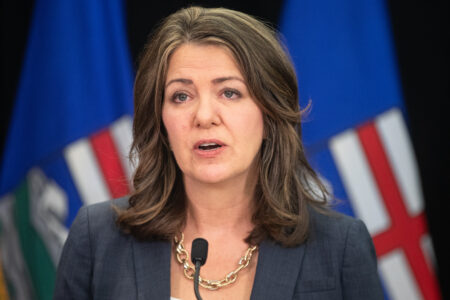
The federal government and its biggest union ended a historic strike with a tentative deal that fell short of expectations for some public servants but set a standard for wages and working from home that others may follow.
The Public Service Alliance of Canada (PSAC) led more than 155,000 federal employees on one of the country’s largest strikes for nearly two weeks. The agreement struck by the federal government and its biggest union could have ramifications for employers and workers across the country as they emerge from a pandemic and wrestle with high inflation and remote work.
The settlement between PSAC and Treasury Board would give workers a 12.6 per cent raise compounded over four years and an agreement on remote work that should open the door to individual arrangements for public servants – but will not be enshrined in the contract.
PSAC President Chris Aylward said the deal is a win for the union and recommended members accept it in an upcoming ratification vote.
“During a period of record-high inflation and soaring corporate profits, workers were told to accept less – but our members came together and fought for better,” he said. “This agreement delivers important gains for our members that will set the bar for all workers in Canada. “
Many labour observers felt PSAC was in a tough spot after the government tabled its final wage offer heading into the weekend’s negotiating session. It became clear the union wasn’t going to get its wage demands so it had to break new ground on remote work and seek other concessions.
The deal ended the strike for 120,000 public servants in the four Treasury Board groups who have been on picket lines since April 19. PSAC said the deal would give workers a one-time, pensionable $2,500 lump sum payment that represents an additional 3.7 per cent of salary for the average union member in the four bargaining groups, on top of the overall wage increase.
The tax people are still on strike
The deal doesn’t apply to 35,000 workers at the Canada Revenue Agency who are still on strike, which will continue to slow the processing of tax returns.
PSAC said it’s at the table for a “blitz of negotiations” to resolve the gridlock. CRA workers had much higher wage demands – up to 30 per cent over three years.
The wage deal for other workers fell short of the 13.5 per cent PSAC demanded over three years – a 4.5 per cent increase per year – to cover inflation. The government dug in its heels pointing to the nine-per-cent raise over three years recommended earlier by the Public Interest Commission (PIC).
Treasury Board President Mona Fortier said the PIC’s recommendation was the baseline. She said the deal will add about $1.3 billion a year to the public service payroll – less than half the cost of PSAC’s original demands.
Although the government can boast it kept raises to three per cent per year, other extras for the different groups have yet to be released publicly.
The agreement on remote work falls short of the breakthrough PSAC sought. Fortier said from the start that how and where public servants work is a management right that she would not surrender.
Instead, the two sides drafted an agreement that remote requests will be assessed individually by managers, in writing. Requests that are denied will go to a joint union-employer panel for review, but they cannot be grieved.
The government’s hybrid workforce model with workers in the office for up to three days a week remains in place. Treasury Board also promised a review of the existing 30-year-old telework policy.
Strikes are unusual in the federal sector because most unions opt for arbitration to settle disputes. This one stood out because of its size and scope with 155,000 striking workers in all kinds of jobs, disrupting services from passports and tax processing to food inspections and grain shipments.
It is also the first major strike in years in a period of high inflation.
A model for others?
PSAC is the largest and most militant of the federal unions. It sets a pattern for raises for all federal public servants, one that is sometimes followed for unionized workers in the provinces, territories and municipalities. The federal government is now in negotiations with 28 other bargaining groups.
Ian Lee, an associate professor of management at Carleton University’s Sprott School of Business, said the government gave “not one penny more” than the three per cent year raise it originally offered. But he argued the government made a “clever compromise” on working from home that will reverberate among workers who are pushing back against returning to offices.
The deal is a far cry from getting a remote work enshrined in the collective agreement, which would have meant workers could grieve decisions. But it remains a significant shift that will affect all workers, Lee said.
He argued the move to individual assessments of who can work from home will offer more flexibility than the government’s previous one-size-fits all approach.
“It will be based on individual criteria of each employee not an arbitrary Treasury Board decision that ‘all units and department must return to work.’ This will be an important precedent for the entire labour force.”
The union also extracted concessions from the government on contracting and seniority rights during layoffs, which bubbled up as sticking points during the last few days of talks.
This is significant because PSAC is girding for job reductions after a seven-year hiring spree. The Liberals announced $15 billion in cuts in the last budget, but the real worry is major downsizing that might be inevitable after the massive growth of the public service.
Government orders public service back to the office
Public service will swell to 409,000 in five years, PBO says
The pandemic upended the federal workplace. What comes next?
Larry Rousseau, executive vice-president of the Canadian Labour Congress, said PSAC increased the “intensity” on contracting and seniority rights to protect against future governments shutting down entire divisions because of automation, AI or privatization.
The union says new language will ensure PSAC members won’t lose jobs if they perform the duties of contractors already working for the federal government. Without retraining, it’s unclear how this will work for contractors who were brought for skills that public servants don’t have.
Departments rely on thousands of contractors, dubbed the shadow public service, who work across government. The exploding cost and use of contractors is currently under study at a parliamentary committee. The union now has a commitment from the government to be consulted on the issue.
Seniority vs. qualifications
PSAC pressed for seniority rights when departments decide on who to lay off – a system where the last hired are the first to go. This would be a significant and potentially polarizing shift for workers, especially for the thousands of newly hired young and diverse workers.
The government currently assesses worker qualifications to decide who gets laid off first. This approach created a demoralizing system of employees having to compete against each other for their own jobs during the Harper government’s downsizing.
The parties agreed to jointly ask the Public Service Commission, the keeper of the merit principle, to examine the possible use of seniority after merit has been applied when laying off workers.
This article was produced with support from the Accenture Fellowship on the Future of the Public Service. Read more of Kathryn’s work here.












